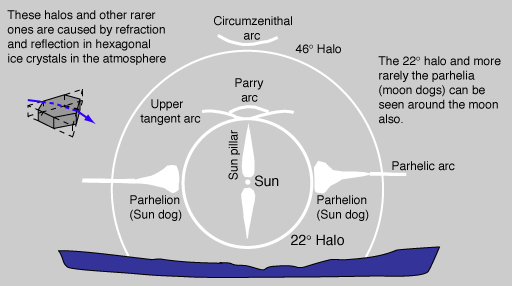Halo Phenomena
In addition to the 22° halo and the sun dogs, a wide variety of other arcs or halo phenomena occur around the sun in cold climates as a result of ice crystals in the air.

Photo by Clay S. Turner. Used by permission. This photo was taken just north of Atlanta in December 1986. While sundogs can often be seen in Atlanta, the other arc phonemena are very rare this far south.

In the photo above are two arcs at the top of the 22° halo which are called upper tangent arcs. All of the halo phenomena shown are attributed to falling hexagonal ice crystals in the atmosphere. Greenler has done a considerable amount of modeling of the origin of the various types of halos and also discusses the modeling done by others. The upper tangent arc is attributed to thin pencil-like hexagonal ice crystals falling with their long axes horizontal. In most images I have seen, there is only one of these arcs, so it is not clear to me how the pair of arcs is formed.
The sun pillar is attributed to reflection off the sides of falling ice crystals. The flare of light around the sun is attributable to Mie scattering off particulate matter in the atmosphere.
| 22° halo | Sundogs (parhelia) | Halo phenomena |
Atmospheric optics concepts
References
Greenler
Schaaf
| HyperPhysics***** Light and Vision | R Nave |